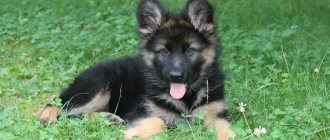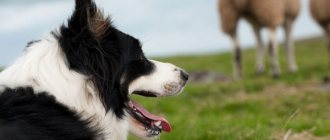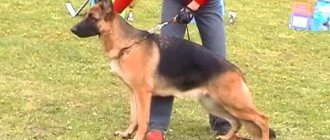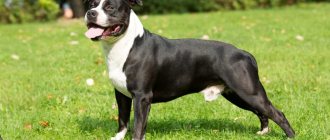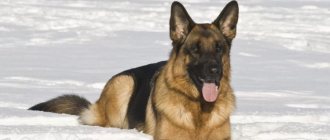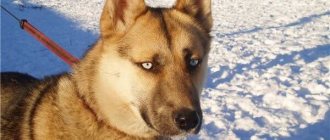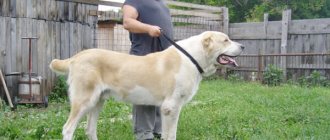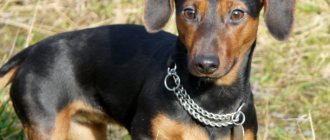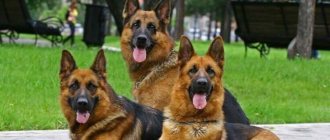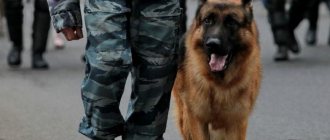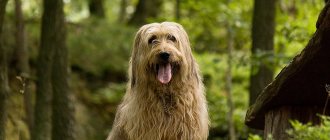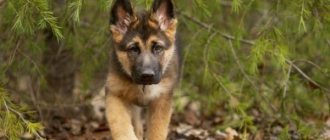It has become common practice among kennel owners to crossbreed their pets with other dog breeds in order to convey the best qualities of both parents. The mixed breed of the Caucasian Shepherd is a clear confirmation that, thanks to the infusion of new blood, the animal inherits not only the external characteristics of both breeds, but also positive character traits.
Care and maintenance
With yard keeping, caring for a cute mestizo will not be a problem even for a beginner. The main thing is that the owner has enough time and desire to take care of his pet.
Hygiene
Simple hygiene procedures usual for dogs are necessary in this case, including:
- cleaning eyes - daily;
- gentle ear cleaning - weekly;
- checking the condition and, if necessary, cleaning your teeth - monthly;
- combing - 2-3 times a week, and during periods of shedding - daily;
- swimming - no more than once a quarter.
Feeding
The diet of mixed breeds, its calorie content and the volume of portions should be calculated taking into account the load on the dog. The more physical activity a pet exhibits, the more energy it must replenish through feeding.
Many owners of huskies are adherents of natural nutrition, but for mixed breeds with shepherd dogs, it is still worth recommending ready-made food: they are balanced and make it easier to regulate the required amount of calories, as well as the ratio of proteins, fats, carbohydrates and mineral and vitamin supplements
You can pay attention to such proven and high-quality products:
- Brit Care Endurance;
- Belcando Adult Active;
- Baskerville Active Dog;
- GO! Natural Daily Defense Lamb Dog Recipe;
- Acana Sport & Agility.
A German Shepherd-Lusika mix can eat ready-made food for active adult dogs - this is preferable to homemade natural food
Video: the wonders of raising a crossbreed Laika and German Shepherd
Walk
A crossbreed between a husky and a shepherd dog will retain puppy activity and curiosity even at a very advanced age. A long walk will always remain important for him - a total of at least three to four hours a day. This rule is also mandatory for those dogs that have the opportunity to move freely throughout the spacious territory of a closed private yard.
Mixed dogs of huskies and shepherds need long and active walking
The complex vaccination scheme is common for all dogs - both purebred and outbred: mandatory vaccinations are given to the puppy at 8 and 12 weeks of age after antiparasitic treatment. If you live in an area with an increased risk of infection, you can carry out a third vaccination - at six months of age, after a complete change of teeth. The first rabies vaccination is given to a puppy at three months. Then comprehensive vaccination is carried out annually throughout the dog’s life.
Working qualities and training
From birth, the German and Caucasian Shepherd breeds are characterized by watchdog and security skills. These dogs were used to herd livestock. They are very diligent and can stay in one area for a long time without changing location.
Outwardly it may seem that the mestizo is very calm, but this is deceptive. If danger appears on the horizon, he will react to it immediately. Thanks to these qualities, a mixed Caucasian with Germans is used for official purposes to organize search operations and protect objects and territory.
Important! Balanced and calm dogs are not empty-headed dogs. They calmly react to extraneous sounds and passing passers-by.
The dog will treat any stranger with caution, but will not show aggression for no reason. He will never attack without warning and will growl first.
The training process should begin as early as possible. Already as puppies, mixed-breed dogs begin to learn commands. It is important that the training process is led by a person who has earned the dog’s trust and become its leader. Training should be carried out in two stages. First, the puppy is trained, and then the acquired skills are consolidated in an adult dog.
Mongrel cross
The size, appearance and character of such a dog largely depend on who its second parent was.
Pit bull and mongrel mixes are rarely above average size. Most of these dogs have fairly short or medium-length hair, semi-erect or almost erect ears, and are predominantly black, red or white in color. There are also brindle mestizos, but the blue or isabella color of the coat of these dogs is very rare.
Among the character traits, it can be noted that crosses with mongrels are distinguished by endurance, mobility and energy. In most cases, they are loyal to people, even strangers, and love children.
However, they often get innate zoo aggression from pit bulls, which makes it difficult to keep them with other pets.
Of all the possible combinations of the blood of a pit bull and other dogs, it is mixed breeds with mongrels that are considered the most unpredictable, since it is not known who the ancestors of their second parent were.
Other mixtures
With Labrador
This mestizo, called the Labrabule, is famous for its intelligence, intelligence, devotion to its owner and energy. It grows up to be slightly larger than a pit bull, and, as a rule, has a lighter build.
His coat is short and dense, his ears are drooping or semi-erect, his muzzle is somewhat narrowed, and his gaze has a serious and attentive, but at the same time, friendly expression.
The color of labrabules can be different, typical for representatives of either of the two original breeds. The most typical coat color for them is fawn, red or black, which most often has white markings.
Labradors rarely have a complex or, let alone, problematic disposition, since the friendly and, in general, softer, albeit mischievous nature Labradors , as a rule, dominates over such traits of pit bulls as innate zoo-aggression and stubbornness.
With Doberman
These dogs, called Dober Pits, grow to a medium to large size. They are very smart, quick-witted and agile. They have rather long legs and a muscular, strong body.
The heads of these mestizos are relatively small, however, their cheekbones are as well defined as those of purebred pit bulls, and their jaws are just as powerful and strong.
The coat is short and smooth, the ears are semi-erect or pink. Some owners of Dober Pits, in order to give their pet a resemblance to a purebred Doberman, crop their ears during puppyhood.
The color can be any, however, there are often more or less pronounced tan marks, typical of Dobermans.
With Rottweiler
Pitweilers, as these dogs are called, are usually medium to large in size. They have a fairly powerful build, well-developed muscles and a wide chest.
The head is quite massive, but proportionate to the body, with high cheekbones and a well-defined transition to the muzzle. The jaws are strong and powerful, although not as wide as those of Rottweilers.
This mixed breed can have any color, however, it often has tan. Three-color pitweilers look especially elegant.
The coat is short and shiny, the ears are semi-erect or pink.
As a rule, such dogs grow up to be smart, quick-witted and devoted to their owner. However, they may have an innate distrust of strangers and aggressiveness towards strange dogs and other animals.
Security qualities
In the past, both Caucasian and German Shepherds were herding dogs, so they naturally have guarding and protective functions. A puppy mixed from these two breeds will have innate guard instincts, and he will cope well with the role of guarding the house and the territory entrusted to him. These huge animals skillfully choose an observation point for themselves, from which they can see all the surroundings and can stay there for hours without even changing their position. But the dog’s calm and tranquility is deceptive; it is always on the alert and ready to react with lightning speed to any threat.
The hybrid will not bark for no reason; it calmly reacts to passing cars, extraneous sounds and people passing by. The dog, in whose veins the blood of Caucasians and Germans flows, is able to adequately assess the situation and make decisions independently. They are distrustful of strangers, but they do not have the aggression and anger inherent in representatives of the Caucasian breed. The half-breed will not immediately rush at the stranger, but will warn him with a threatening growl that he should not come closer.
The crossbreed is distinguished by its flexible character, easy to train, and friendliness to other animals.
Unlike the same Caucasian Shepherd Dogs, the hybrid is loyal to other pets. Mixed breeds perceive small defenseless animals, such as cats or toy dogs, as objects that need to be protected. The picture looks quite cute when an impressively sized dog allows a tiny kitten to pull its tail or climb onto its wide back. But mixed breeds do not get along with other large dogs and will prove their superiority in a fight with them. Peaceful coexistence of two such dogs in one home is only possible if they were raised together from a young age.
A mixture of these two breeds is highly trainable; they do not have the stubbornness and willfulness of the proud Caucasian Shepherd Dogs. Mestizos are obedient and disciplined, quickly remember commands and meekly carry out all the orders of the owner.
Character
Caucasian Shepherds are strong-willed and independent dogs with intelligence, determination and courage. They are fearless, persistent and confident. A Caucasian will never back down from a fight and is ready to fight even with an opponent who is superior in strength, leaving the enemy not a single chance to win.
German Shepherds are characterized by such qualities as high intelligence, courage and insight. But at the same time, they are friendly, playful and active animals who happily play with children and play pranks with other pets.
A mixture of German Shepherd and Caucasian is a combination of the most positive character traits of the two breeds. Mestizos have an amazing combination of courage, friendliness, determination and energy. Hybrid puppies are good-natured, playful and inquisitive. They are loyal and loving pets who are always ready to serve their owner, keep him company on walks and take part in a fun game together.
Caucasian and German mixed breeds inherit the best traits from both breeds
Types of Shepherd Dogs
Numerous peoples living in the Caucasus, according to centuries-old traditions, tamed Caucasian Shepherd Dogs.
Currently, there are several varieties in the world, depending on their habitat:
- Georgian type. Such Caucasians are massive, tall dogs with a slightly elongated body and long hair of a single gray color.
- Armenian type. These dogs, like individuals of the Georgian type, have long, monochromatic hair, but in size they are not so tall and massive.
- Dagestan type. Caucasian Shepherd Dogs of this variety are the largest. They have a square body and a variety of coat colors and lengths.
- Azerbaijani type.
The latter, in turn, are divided into 2 subspecies:
- mountainous (reminiscent of Georgian-type Caucasians);
- steppe (short-haired dogs of dark fawn and sometimes red color with a square body, long limbs and short hair).
A cross between a Caucasian Shepherd and an Alabai: distinctive features of appearance
The dogs resulting from the marriage of Caucasian and Central Asian Shepherds are of impressive size and powerful build. The appearance of mixed breeds displays the characteristic features of both breeds, which allows unscrupulous breeders to pass off mixed puppies as purebreds.
What does a mixed breed of Alabai and Caucasian look like?
The dogs' bodies are strong and strong, but they are more reminiscent of the squat and powerful Caucasian Shepherd Dogs rather than the slender, athletic Alabais. The legs are of medium length, thick and muscular. Puppies' tails are sometimes docked and sometimes left on. If the baby has not been docked, then the tail of an adult mestizo will be long and fluffy.
Half-breeds have thick and long hair, inherited from Caucasians. There is a luxurious mane on the neck and chest, which is why the animal’s head appears huge and ball-like. Dogs' coat color can be:
- white;
- gray;
- beige;
- dark brown.
The back, tail, upper part of the head and paws are painted in a darker shade.
The cross between an Alabai and a Caucasian in the photo embodies the grace of one breed and the power of another
Violations in the standard
Why a dog can be rejected, for example, for improper behavior in the ring. Aggressive behavior towards judges or other dogs, cowardice or disobedience may result in disqualification from the show.
Dogs with cryptorchidism are screened out based on physical parameters. Moreover, one of the conditions of the standard is pronounced sexual characteristics.
A dog that is overweight or has a loose body structure is also not suitable for exhibition. Incorrect proportions as well as insufficient height of the shepherd at the withers are signs of a violation of the standard. Too light or heavy bones, long or crooked legs, a docked tail will not allow the pet to compete with its fellow tribesmen.
Culling can also be carried out based on the following criteria:
- too light coat color or incorrect pigmentation;
- malocclusion or missing teeth;
- inappropriate muzzle parameters;
- soft or floppy ears;
- bifurcated or unpigmented nose.
Dogs with defects and defects are not allowed for breeding.
Keeping at home
In the apartment, the dog is given a separate, permanent place, to which the animal will be accustomed from childhood.
Considering that the coat is thick, the lounger is placed away from heating radiators. Care must be taken to ensure there is sufficient light and no drafts. The resting place should be organized taking into account the size of the animal. Mandatory presence of fabric bedding. It is cleaned and treated with disinfectants (approved for use) once every two months. Possibly more often as it gets dirty.
Caucasian Shepherd puppies in the meadow in summer
The dog's permanent place should not be near the kitchen or dining room. Near the refrigerator and in a walk-through area. The shepherd dog kept in the apartment is walked in the morning and evening.
Characteristics of mestizos
Puppies of a mixture of husky and shepherd are called mixed breed, this animal has several names: Gerberian shepherd, Siberian shepherd, German, and also herding husky. These dogs are classified as working, guard, and companion dogs. The height of a male is usually from 550 to 650 centimeters, and that of a female is 450-550 centimeters. At the same time, adult males weigh from 35 to 50 kilograms, and females weigh 10 kilograms less. They are usually long-haired and have medium-length fur. The fur is coarse, dense to the touch, and has a voluminous but soft undercoat.
A husky/shepherd cross has a large build. The dog took on the external characteristics of a shepherd dog, its body structure and color. Some Shepsis have a special slope of the back and croup, which is characteristic of the “Germans”. A pet's fur can have a variety of colors, mixed, which have their own richness, shades, and inclusions. The most common fur coat colors among mestizos are:
- black;
- black-brown;
- white;
- chocolate;
- ginger;
- golden;
- grey;
- zonal.
From the husky, the animal inherited thick fur and light bones. Mixed breeds are also characterized by an eye color that only huskies have, namely blue. The dog's appearance is quite original: shepherd fur combined with blue eyes. Some representatives have white markings and masks on their faces. The advantages of this breed of animal include the following:
- beauty and originality of appearance;
- friendly, sociable, loyal character;
- sharp mind and quick wit;
- loyalty to children;
- ability to withstand cold;
- no need for special care;
- unpretentiousness.
The husky-shepherd hybrid also has disadvantages:
- unsuitability for serious work;
- territoriality;
- lack of aggression towards strangers;
- stubbornness;
- food selectivity;
- cunning, self-will;
- abundance of shedding.
Mixed Labrador and German
Dog breeders say a lot of good things about Labrador and German puppies - this species turns out to be perfectly balanced. Let's remember that Labradors have a much calmer character than Germans - this is perfectly balanced in common puppies.
The result is a dog with a calm temperament, which is perfect as a company for children - he is ready to play, he is cheerful, but not too much. And if necessary, he can come to the defense and is ready to defend the child to the end.
In addition, Labrador mixes, as a rule, have an extremely attractive exterior - the aesthetic component should not be discounted. Therefore, such dogs are quite in demand among supporters of new trends who welcome “mixed marriages” between representatives of different breeds.
Mixed Labrador and German
Types of Labradors: what colors are there?
Labrador color.
The breed standard provides for only three colors: black, fawn and chocolate.
When dogs of this breed first attracted the attention of Europeans, they were all black. Large shaggy black dogs appeared on the island of Newfoundland, the real homeland of Labradors.
Newfoundland is separated from the Labrador Peninsula by the Belle-Ile Strait, but for some reason the name of the breed was given by the peninsula. Black coat color was originally inherent in the breed. This is a dominant color, that is, if a puppy has the black color gene, it will in no case be fawn.
The thick, shiny coat of the black Labrador is very beautiful. It is a bit reminiscent of the mineral labradorite, sometimes even glowing with bluish reflections. A black Labrador dog looks the most impressive of all, since people subconsciously treat black dogs more warily and respectfully.
Black dogs are allowed to have a small white spot on their chest. White spots in other places are unacceptable. The eyes should be brown or light brown, but the darker the better.
Fawn or yellow Labrador.
Fawn or yellow Labrador. Puppies of light colors were born a long time ago, but at first they were considered defective and excluded from selection. Then it was decided that fawn or golden color was no worse than black, and in 1924 this color was included in the breed standard and quickly gained popularity.
Light dogs are incredibly expressive and charming. The color intensity can vary from cream to fox red. The ears and back are always colored a little more intensely, but there should not be a darker mask on the face. A small white spot on the chest is allowed. The eyes can be hazel or brown, but always with intense black eyelids and nose.
And yet not white...
Sometimes the coat is so light that it seems as if you are looking at a completely white Labrador, but this is not the case. There is no white color in the genetics of the breed at all. One has only to put the lightest Labrador and a truly white dog (Samoyed, for example) next to each other, and it becomes clear that the Labrador is far from white, but still cream.
Chocolate or brown Labrador. These are the fewest puppies born. Chocolate color is determined by a set of dominant and recessive genes, and in various combinations of these genes a more or less intense coat color can be obtained.
The light types are called liver, the medium brown is called chocolate, and the darkest is like dark chocolate. As with other colors, a small white spot on the chest is not considered a fault. There should be no other white markings. Eyes can be amber-yellow, brown, hazel.
In all three colors, black nose and dark eyelids are preferred. However, during the cold season, the nose may lighten to pink or light beige. This phenomenon is called “winter nose” and is not considered a defect. Summer will come and the nose will darken again.
Mixed German Shepherd - features
Mixed breeds are born from two different breeds of dogs. They usually take the best from their parents. They have good health, a stable psyche, a high level of intelligence, and no tendency to genetic and other diseases thanks to a strong immune system.
Designer crossing is a young concept, but nevertheless it has become popular among those who like to breed a new, unique dog with a certain appearance by mixing two completely different breeds. These designer dogs are quite expensive.
general characteristics
Mestizos are sold much cheaper than their purebred parents. They are often given away as gifts to lovers of four-legged friends. Their big advantage is excellent health. When selecting new types of breeds, attention is focused on their appearance and exterior.
At the same time, the health of the pets suffers greatly, since crossbreeding often occurs between close relatives. Mixed breeds do not suffer from this. However, you need to pay attention to their health, get vaccinated, and visit the veterinarian regularly.
It is impossible to guess the height of an adult mestizo, you can only guess by the size of the animal’s paws. A small mother can give birth to a puppy who will grow up to be big. It is also very difficult to predict the color of six future puppies; they may resemble both parents. The genes of half-breeds cannot be calculated. They can manifest from their distant ancestors.
You never know what will happen when crossing two breeds
What types of mestizos are there?
Alabai is a Central Asian Shepherd Dog. The appearance of mestizos depends on what breed the crossing took place with. Excellent external and physical characteristics are inherent in the cross between the Alabai and the Caucasian Shepherd. This is a strong dog that has inherited the power of the “Caucasian”, his dense and beautiful coat. In the neck area it is so thick that the head seems very large and round, like a ball. The beast inherited grace from another ancestor.
The paws of such an animal are strong. Some owners dock their puppies' tails. If you leave it, then in an adult dog it will be fluffy and long. As for coat color, it can vary from white to dark brown. In this case, a darker shade will be present on the back, top of the head, tail and paws.
It is impossible to predict the appearance of an Alabai crossed with a German Shepherd. It all depends on which gene takes over and becomes dominant. You don’t even need to be an experienced dog handler to not understand which breeds took part in the mating. The features of a “German” and a “Central Asian” are noticeable quite well. The adult specimen is impressive in size. There may be a dark stripe on the back, and the muzzle is also dark.
If the Central Asian Shepherd gene is predominant in Alabai and Cane Corso mestizos, then the offspring grow large with thick fur. The massive square muzzle is a distinctive feature of the individual. Ears and tail are docked in puppyhood. The color is mostly dark.
Alabai and East European Shepherd puppies are very fluffy babies with semi-erect ears. As they grow older, the dogs become more like the Eastern European species. The color of the fur on the face, ears and along the spine is darker than the main one. The tips of the paws may be white.
The Tibetan Mastiff crossed with the Central Asian Shepherd Dog grows into a large individual. A powerful torso, large paws, dense hair, hanging ears are the characteristic features of a crossbreed. The color can be very diverse: from black with a white chest to red. It happens that the muzzle, bridge of the nose and forehead (in the middle) are white.
A crossbreed with the Moscow Watchdog, this is a graceful dog with powerful and strong paws, a broad chest and a thick undercoat. The tail of such individuals is docked. The ears are triangular and drooping. The inside of the paws, belly and chest may be completely white.
The mixed breed of Alabai and Rottweiler has quite large shapes. Its weight can reach 70 kg. This is a very beautiful dog, with thick long hair and drooping ears. The tail is docked at the owner's request. Red-colored individuals whose upper body (back, sides and neck) are covered with black hair look very impressive.
The Husky cross inherits the Alabai's large build. Coat color, blue eyes, erect triangular ears are a manifestation of the husky gene. The fur of this pet is dense.
A Central Asian Shepherd dog crossed with a Labrador retriever produces good offspring. Adult individuals are somewhat less impressive in size than the alabai. Dogs are characterized by playfulness and an active lifestyle. Fawn coat color is common.
The Shar Pei inherits the Alabai's original color and courageous character. This is an excellent watchdog with a powerful broad chest and massive paws.
But a cross with a mongrel is a completely unpredictable option, regarding both the appearance and the character of the animal. The probability that the mongrel gene will be predominant is quite high.
Expert recommendations
Even despite their balanced psyche and good trainability, the character of Caucasian Shepherd Dogs remains dominant. They need to demonstrate their leadership qualities at all costs. To overcome this desire and turn it in a positive direction, it is necessary to take into account important nuances in upbringing. All of them are structured and presented in the form of a convenient table.
Table 3. Recommendations for training “Caucasians”
Character Nuances of education Training and education Features of positive and negative reinforcement Wolfhounds are very proud animals. Under no circumstances should you use an electric collar when training, shout loudly if the puppy does not obey, and it is strictly forbidden to hit your pet. Otherwise, the Caucasian Shepherd will grow up embittered and become dangerous for the owner and others. Unconditional obedience can only be achieved by setting clear goals for the pet. To carry out commands, the dog must understand the logic of the actions that are required of it. The little “Caucasian” can be taught commands during active play, so that the pet’s interest in learning awakens. As the dog gets older, games become the dog's responsibility. You cannot start learning a new skill without fully mastering the previous one. Each lesson must be repeated more than once. Every time after the correct execution of a command or any other action, you need to praise your pet. You can encourage him with pleasant words, strokes or treats. The offending pet should be scolded, but without raising your voice. The owner's reaction should not be late: punishment must occur before 5 minutes have passed from the moment the offense was committed. The wolfhound's genes still contain hidden aggression, which helps the dog protect its pack. The owner, who cannot subdue the dog, will no longer be able to slow down his attempts to attack the stranger. Attacks on defenseless people must be stopped at the very beginning. Until 4 months of age, raising and training a puppy falls entirely on the shoulders of one owner. No one else should be allowed to pet, give food or raise a pet. Otherwise, the owner will never become an authority and leader for the pet, so he will not obey. If the owner understands during the training process that the dog is not self-confident, it can be supported by the presence of a stronger “Caucasian”. When raising a young male, preference can be given to a stronger male, and when raising a female, preference can be given to a healthy and confident male. If a small puppy has done something wrong, it is enough to take him by the scruff of the neck and shake him. An already grown puppy needs to be pulled by the leash. Actions must be reinforced with the command “No!”, said in a stern voice, but without shouting. There is no need to try to suppress the natural instincts that were passed on to the dog along with the genes of their ancestors.
Otherwise, your four-legged friend will turn into a weak creature that does not know how to perform its functions or will become an uncontrollable beast. When starting to raise a “Caucasian,” you should pay maximum attention to the three most important commands: “Stop!”, “Near!” and “Come to me!” You should never be disappointed in your four-legged friend. If he can’t follow commands, train again and again, practice your skills diligently
Even the laziest dog can be trained and made an obedient guard. A puppy who has misbehaved on a walk cannot be punished after being called to you.
Otherwise, the phrase “Come to me!” will be associated with getting a thrashing. The command is easily reinforced at home: the pet needs to put food in a bowl and call it to you
Adult Caucasian Shepherd
How to choose the dog of your dreams?
The catalog presents mixed-breed puppies as a gift in Moscow, which are given by volunteers from shelters or by their owners into good hands. There are also adult dogs here with already formed character and temperament. The selection filter allows you to select an animal according to the necessary parameters: gender, size, purpose (for family, hunting, protection), coat length.
Thousands of homeless animals are looking for a new home. Check out the advertisements, on each you will find a photo, a description of the dog’s fate and contact information for the temporary owner. Choose your pet with your heart, and when you find “yours,” contact the author of the ad.
How to properly cook bream at home
To avoid pitfalls in the form of bones and smell, you can use simple techniques to prepare bream dishes without unnecessary hassle.
- To get rid of the unpleasant smell of fish, sprinkle the carcass with lemon juice, or even better, soak it in the juice for an hour (use a whole lemon per liter of water).
- When frying bream, do not make the pieces too thick, this will allow them to cook evenly. The ideal thickness of steaks is 3 centimeters, otherwise the top of the fish will be fried, but the inside will remain raw.
- Place the steaks only in hot oil, then the fish will not stick to the pan and will easily turn over to the other side. I know another simple trick: salt the oil in a frying pan over the entire surface, and then lay out the steaks. True, this salt must be taken into account when you begin to salt the fish itself.
- Fish meat will become much more tender if you marinate it in lemon juice. To improve the taste of bream, various herbs and seasonings are placed in its belly, then the meat will have time to soak from the inside during baking.
- To avoid suffering from small bones, cook the bream whole, or choose large carcasses, which have few bones.
Breed characteristics
The Caucasian Shepherd is a large dog with a powerful constitution and abundant hair. They have sexual dimorphism - females are noticeably smaller, with a narrower muzzle. Males may have a characteristic scruff on their neck. The World Canine Association classifies the breed as Group 2, Section 2.2 - Molosser/Mountain Dogs.
How many years do they live, weight, height, dimensions
The average life expectancy is 10-11 years, but this is only if they live on the street. If a dog spends more time in the house, and this happens, its lifespan is reduced. The desired height at the withers for males is 72-75 cm, but not less than 68 cm. Bitches are significantly smaller: 67-70 cm, but not less than 64 cm. However, a height above the specified values is not a serious defect.
The most reliable watchman Varvara
How much does it weigh
The average weight of females should not be less than 45 kg, for males the minimum value is 50 kg. Maximum weights greater than these values are welcome.
Head
The head is wide and large, looking like a blunt wedge. The transition from the forehead to the muzzle is present, but not very pronounced. The nose is only black. Other pigments such as brown or blue are not allowed. In individuals with a light color, seasonal changes in the color of the nose are possible.
Dogs have a large muzzle with strong jaws. The bite is correct (scissor). The absence of 1-2 molars or incisors is not penalized in show animals in the ring if they do not affect the bite in any way. The muzzle is level and parallel to the forehead, gradually tapering from base to tip.
The eyes are slanted, medium in size, oval in shape. The iris of the eyes is only brown, for example, dark hazel. The shape of the eyes visually creates the image of a thoughtful and serious dog. The ears are medium, in the shape of a triangle. The base fits tightly to the skull. In their historical homeland they are docked short. However, ear cropping is not mandatory.
Neck and body
The neck is low, but wide and massive. The scruff is formed only in males with a long coat type. The body is well developed: it is wide, strong, harmonious. The format is slightly elongated, especially in females. The back is straight and strong. The withers are moderately expressed. The chest is deep, developed, strong. The front of the chest area protrudes slightly forward. The abdominal line is moderately developed.
Tail and limbs
The tail reaches the hock joint. A calm dog keeps it down. In other cases, the tail is crescent-shaped or in the form of a half ring. Cupping is not allowed.
The limbs are parallel and muscular. Set wide apart. The movements are leisurely and calm. Dogs are characterized by a powerful leap of the hind limbs. Representatives of this breed prefer to trot, sometimes breaking into a gallop.
Coat and colors
The coat is abundant, non-lying, at least 5 cm. It is smaller in some areas of the body - on the limbs (in front) and on the muzzle. The undercoat, like that of the Keeshond, is thick. The tail is heavily covered with long hair, due to which it looks even larger and more massive.
The standard specifies spotted (piebald) colors, but solid colors are also allowed. Solid black is excluded, despite the fact that the Caucasian Shepherd took part in the development of the Black Russian Terrier breed. Blue, fawn and chocolate colors are also not allowed. An optional element is the presence of a black mask on the head, which, however, is very common in the breed.
Among working dogs, color varies greatly. It can be fiery red, golden, brindle and even white. Rage but controlled
Height and weight by month
The initial stage of the life of such a shepherd dog begins from the moment of its birth until 7 weeks. When born, the weight of puppies is usually 0.6-0.8 kg. If the newly born kitten weighs less than 600 g, it is unlikely to grow into a large dog.
Too large a puppy also does not guarantee ideal health. Before buying such a pet, whose weight at birth was more than 800 g, you need to visit a veterinarian and ask him about whether the animal has any congenital disease.
In the first month of life, namely from 15 to 20 days, dogs need special treatment from the owner. This is a serious stage in the development of a Caucasian. During this period, his auditory and visual perception of the world develops. The puppies begin to explore the objects around them. At this age they can already walk.
When little Caucasians turn 2 months old, they begin to gain 400-420 g daily. As a result, the weight of two-month-old Caucasians averages from 13 to 19.6 kg.
At 3 months old, little Caucasians are still a little clumsy and clumsy. Gradually, their limbs and neck begin to “stretch.” The body takes on an oval structure. The head grows in size, as does the chest. During this time period, young individuals externally resemble bear cubs.
Three-month-old Caucasians are still growing rapidly, maturing and gaining weight. Every day they gain 200-400 g. As a result, a pet at this age should weigh from 18 to 32 kg. At the withers, the height of girls is usually 43-46 cm, and that of boys is 45-49 cm.
When babies turn 4 months old, their weight should average 25-60 kg. Five-month-old dogs of the Caucasian breed have a maximum weight of 64 kg, and the smallest - 35 kg. At this age, animals acquire their natural color. In adolescents, molars grow rapidly and ears rise. At this stage, the young dog looks almost the same as the adult.
Upon reaching 6 months, young shepherd dogs usually weigh 40-94 kg. The height of individuals at the withers for males is 63-68 cm, and for girls - 59-63 cm. It is at this moment that females may experience their first heat. However, experts do not recommend breeding dogs of this type at this age. It is better to do this no earlier than when Caucasians turn 2 years old.
After 6 months, such dogs stop growing as rapidly as before. In 4 weeks they can gain approximately 1700 to 5160 g. Typically, a 7-month-old Caucasian weighs 41.7-99 kg.
Eight-month-old animals weigh from 43.4 to 104.4 kg. The difference between the largest and smallest weights is largely due to the genes of the parents, the state of health of the individual, as well as the correctness of its maintenance.
Nine-month-old purebred dogs typically weigh between 44.8 and 109.5 kg. These are already almost fully formed individuals. True, they will still continue to grow, although not so rapidly.
Many of the representatives of this breed grow until they are 10 months old. Having reached the specified age, such a dog looks like an ordinary adult. A 10-month-old male will weigh between 46.2 and 114.6 kg.
From 6 months to a year, the mass of the described animals increases by a third. For females, the normal weight is 40-115 kg, and for males - 50-125 kg. The height at the withers for males is usually 68-78 cm, and for females - 64-72 cm.
If you have purchased a puppy of the breed described, then you should monitor how it grows and develops. Height and weight values most often indicate the health status of pets. For example, slow growth or stopping may indicate the presence of certain diseases or deficiencies in the diet. It is better to keep on hand a detailed table that shows all the necessary indicators for a growing dog.
| Month (animal age) | How much does a male dog weigh? | How much does a bitch weigh | Height at the withers of a male dog (in centimeters) | Height parameter (measured at the withers) |
| 1 | 4000-6800 g | 2500-4500 g | 24-26 | 23-25 |
| 2 | 13000-19600 g | 11500-18000 g | 34-37,5 | 33-35,5 |
| 3 | 18000-32000 g | 16500-30000 g | 45-49 | 43-46 |
| 4 | 25000-60000 g | 22000-50000 g | 51-55,5 | 48,5-51,5 |
| 5 | 35000-64000 g | 32000-60000 g | 57-62,5 | 54-57 |
| 6 | 40000-94000 g | 35000-92000 g | 63-68 | 59-63 |
| 7 | 41700-99000 g | 35700-96200 g | 64-70 | 60-65 |
| 8 | 43400-104400 g | 36500-100600 g | 65-72 | 61-67 |
| 9 | 44800-109500 g | 37200-104800 g | 66-74 | 62-69 |
| 10 | 46200-114600 g | 38000-109000 g | 66,5-75 | 63-70 |
| 11 | 47600-125000 g | 38600-113200 g | 67,5-76 | 63,5-71 |
| 12 | 50000-125000 g | 40000-115000 g | 68-78 | 64-72 |
Who are mongrels?
This is the most numerous order, whose representatives are called “complex polyhybrid” by experts, and people simply call them mongrels. Pedigree dogs have been bred for decades, collecting the best qualities in each offspring. For some, flair is of paramount importance, for others - strength and endurance. Any puppy from a purebred dog is predictable - it is always known in advance what will grow out of it. For example, spaniels can only produce a spaniel and not any other breed.
Mongrel puppies are the result of free crossing, so neither appearance nor character traits are fixed at the genetic level. A small fluffy ball can grow into a charming and intelligent dog, although it is possible that it will not live up to expectations either in its external qualities or in its intelligence. This, however, happens very rarely. Most owners of mongrels would not exchange their pet for any dog, even the most beautiful purebred one. It is very difficult to classify mongrels, they are so diverse.
This is another species of a large order called “mongrel dog”. They are a mixture of different breeds, possibly spanning several generations. Often it happens randomly, but sometimes it is planned. Having received the best from their parents, mestizo breeds enjoy excellent health. They usually do not have genetic diseases. But character is not always ideal. It is difficult to predict what traits a puppy will inherit from its parents. Small mongrel dogs often show aggression towards children and animals. Larger breeds can be difficult to manage and train.
Nevertheless, such dogs are in demand among people who, for financial reasons, cannot afford to purchase a purebred puppy. The price for mixed breeds is much lower, and sometimes you can get a non-purebred puppy as a gift. Recently, the Labrador mix, obtained from crossing with a poodle, has become very popular. It was specially bred and even got its own name - Labradoodle. This is an excellent guide, capable of working even with disabled people who have special difficulties. The Labradoodle is suitable not only for people with disabilities, but also for those who are allergic to animal fur. These dogs are excellent nannies, so families with children are happy to take them.
It is not uncommon today to have a Labrador mix, obtained by crossing a dog of this breed with a German Shepherd, a Husky, or a Shar Pei. Having inherited the best qualities, such dogs also have a very unusual appearance.
Advantages of mixed breeds over purebred dogs
Owners of hybrid puppies resulting from crossing German and Caucasian breeds give only positive characteristics to their pets. The owners assure that such mestizos have a lot of advantages, and they are more manageable, flexible and friendly than their purebred parents.
Among the advantages are:
- a cross between both shepherd dogs has a peaceful, calm and obedient disposition;
- they are patient and affectionate towards children and get along well with small pets;
- Mestizos are loyal and reliable guards;
- they are easy to train and train;
- animals can easily tolerate any weather conditions and can be kept outside all year round;
- they are not characterized by the rage, aggression and hostility that are characteristic of their Caucasian ancestors.
Important: given the impressive size of dogs, they are not suitable for keeping in an apartment. These animals feel comfortable only in a private house with a spacious and extensive territory.
The Caucasian and German Shepherd mix looks stern and threatening, but in fact it is a kind, peace-loving and affectionate dog. You can leave your children under his supervision, he will take care of the security of the house and will become a faithful, loving friend for the whole family.
Description of the Czechoslovakian Wolfdog breed
If the first two offspring showed good performance characteristics, then the third showed an external resemblance between thistles and wolves. But still they differed from both of them. The breed standard, which is still preserved, was bred back in the 70s and 80s.
It is a large, wiry dog, wolf-like in appearance, with a rectangular, balanced body. From birth she has developed muscles and strong teeth. Thanks to wolf instincts, representatives of the breed turned out to be universal dogs.
The physique of hybrids is designed in such a way that they can run long distances:
- The muzzle has clean, clear lines, the lobe is pigmented black, oval. The bridge of the nose is straight, the lips are dry, tightly fitting, with a black edging. The teeth are well developed, the canines are long, sharp, with a straight or scissor bite.
- The eyes are medium in size, somewhat slanted, with a yellowish-amber iris. The ears are small, triangle-shaped, erect.
- The tail is located high, in a calm state it hangs; when the dog is excited, it forms a sickle and rises.
- The limbs are tall and muscular. Dewclaws may appear, which is undesirable - they must be removed.
Coat and colors
The Czechoslovakian Wolfdog has a thick, straight coat. Moreover, winter and summer wool differ significantly. The winter coat has an abundant, dense undercoat, and together with the guard hair it forms excellent protection from the cold. The fur covers the entire body, and even the stomach, thighs, including the inside, the testes, the inside of the ears and the paws between the toes.
The color of thistles is characteristic - it varies from yellow-grayish to gray-silver. A light-colored mask is required. There is also light hair on the neck and front chest area. In addition, the standard allows individuals with a dark gray color and a light mask.
History of the Caucasian Shepherd Dog breed
Caucasian Shepherd Dog
Caucasian Shepherds are among the oldest dog “clans”, the history of which dates back thousands of years. For example, the ancestors of today's wolfhounds grazed sheep flocks in the foothills of the Caucasus long before the advent of Christianity. As for the origin of the breed itself, its founders are considered to be the Tibetan Great Danes, which in Ancient China were used for baiting and fighting. Some experts call the homeland of dogs southwestern Asia, or more precisely, the Urartu-Ararat kingdom, where the animals were in the service of cattle breeders and from where they began to disperse across adjacent territories.
An interesting fact: the first “breeders” to whom Caucasian Shepherds owe their outstanding guard instinct were ancient shepherds. It was they who were in charge of breeding animals and selecting puppies, cultivating and successfully developing useful performance characteristics in them. For example, a real shepherd dog, in the understanding of Caucasian shepherds, had to have endurance and sufficient strength to deal with an attacking wolf. In addition, she was prescribed unpretentiousness in food and insensitivity to sudden changes in air temperature.
The impetus for the appearance of shaggy “highlanders” in tsarist Russia was the Caucasian War. Participants in the hostilities brought dogs as living trophies, but none of the newly minted shepherd dog owners had any desire to seriously engage in breeding the breed. Domestic breeders began to take an interest in wolfhounds only in the 30s of the last century, after the Nuremberg Exhibition, but their breeding research was interrupted by the Second World War, which destroyed the entire gene pool of Caucasians. It was possible to more or less restore the breed in the USSR only in the early 70s. Around this time, consumer demand for Caucasian Shepherds began to grow.
Differences
If the owner definitely wants to have a purebred puppy, then he should be careful when choosing a breeder. Not all of them are decent; under the guise of a purebred puppy, they can sell you a mixed breed of shepherd and mongrel. You can distinguish a purebred shepherd from a mixed breed by the following characteristics.
- Already at 2 months, a purebred shepherd cub is larger than its non-purebred counterparts. It has more powerful and robust paws with strong joints and no curvature.
- You can notice a distinct furrow on the mongrel’s forehead, which is not found on the shepherd dog.
- A purebred dog always has a scissor bite, but a mongrel can have any bite.
- As a shepherd dog gets older, its ears become hard and stand up on its head; mixed breed dogs have ears that remain hanging down.
- A mongrel/shepherd mix has a barrel chest, while a purebred puppy has a wide and massive chest.
Advantages and disadvantages
Perhaps, of all the varieties of mongrels, it is the cross with a shepherd that is most common. Such dogs can be found at a dog park on a leash with their owner, or they can also be seen in a stray dog pack. According to the description, the dog still looks more like an unknown parent than a shepherd. Compared to a purebred pet, mixed breeds have their advantages:
- Shepherd and unknown breed puppies turn out stronger and healthier;
- mestizos are resistant to genetic diseases;
- such puppies have stronger immunity;
- their intelligence begins to manifest earlier;
- the cost of non-purebred puppies is noticeably lower;
- Mestizos are less likely to need special, expensive food.
Before getting a mixed-breed puppy, it is important to familiarize yourself with its disadvantages:
- it is unknown what size the pet will grow;
- non-purebred animals do not have documents or pedigree;
- cannot participate in the exhibition;
- You cannot know in advance what kind of character a dog will grow up to have.
Possible diseases
The formation of the dog was influenced by the historical habitat. The animal is tolerant to low temperatures and resistant to diseases. Timely vaccination will minimize infectious diseases. The created conditions that meet the physiological requirements of the animal will eliminate a number of health-related pathologies.
Having become the owner of a Caucasian Shepherd, you need to know what diseases threaten it. What clinical signs are worth paying attention to:
1. Infection with plague, hepatitis, leptospirosis will be accompanied by: fever, lack of activity, refusal to feed, vomiting and diarrhea.
2. Metabolic disorders due to poor diet, risk of developing agammaglobulinemia with infectious symptoms.
3. Hormonal imbalance leads to diabetes. Signs of the disease will be weight loss, constant thirst, dry mucous membranes. Hormonal imbalance will lead to abnormal location of the testicles, dwarfism, and gigantism.
4. Diseases related to musculoskeletal function: dysplasia, sagging of the hind or front legs, lameness.
5. Pathologies of a neurological nature: neuroses, muscle spasms, epilepsy.
At the first signs of illness, you need to contact the nearest veterinary clinic for help. One of the most common diseases is obesity. If there are no disturbances in the endocrine system, then the reason is improper feeding. It is necessary to reduce the amount of food and increase the frequency of walks.
Nutrition
The Caucasian Shepherd breed is not demanding on its diet, but you need to know the nuances in feeding an adult animal. The frequency of meals depends on the time of year and the age of the dog. In winter, when kept outdoors, they are fed 2 times (morning, evening). In summer, evening meals can be eliminated by increasing morning meals. After the dog has eaten, the cup should be empty. If food remains, it is necessary to reconsider the diet and portion size. An approximate calculation of liquid food is 50 grams per kg of weight. Dry 15 g per kg body weight.
It is necessary to give solid food, pre-boiled trimmed bones. A lactating female has three meals a day. How well the feeding is organized can be determined visually. According to the condition of the coat, weight stability. The stomach is retracted or, on the contrary, saggy.
Mandatory presence on the menu:
- meat products:
- sea fish;
- all kinds of cereals, the dog will make its own choice which ones it likes best.
It is not recommended to overuse pasta and give fresh white bread.
Differences up to one month of age
If anyone who has ever encountered pedigree dogs of this group can already distinguish a shepherd from a mongrel at the age of 5-6 months, then not everyone will be able to make the right choice at the age of 3-4 weeks. What should you pay attention to at such a tender age?
Mom and Dad
Never buy a puppy without making sure that its parents correspond to the breed characteristics of the German Shepherd. The best evidence in this case is the correct documents for the parents and the children themselves.
To reassure yourself, you should call the club and find out if mom and dad are registered there.
Attention! The club may refuse permission to breed if one of the parents has hip dysplasia.
This is a hereditary disease (genetic predisposition), the symptoms of which may appear only at 6-12 months of age: lameness, increased fatigue, joint pain, unsteadiness of gait, X-shaped stance of the hind limbs.
Hip dysplasia is a real scourge of large breed dogs (which includes the German Shepherd). Treatment is long, painful and not always effective.
Brand
Confirmation of documents is a mark on the inside of the hind paw of both the parents and the puppy itself. Plus the metric, of course.
The stamped mark and the information about it in the metric must match!
If the baby does not have a mark, then, most likely, the mating was “left-handed”; the club did not give permission for it. Such a puppy can be purchased as a pet - this is a real shepherd dog, which has received breed characteristics from its parents, both in appearance and psyche, but the path to the ring will be closed to it.
